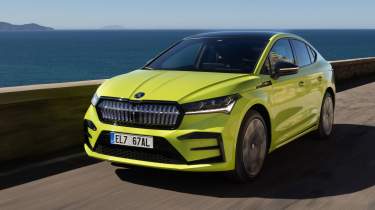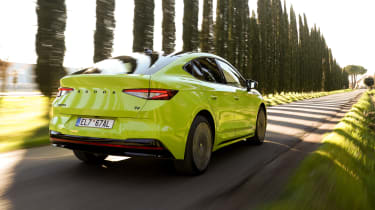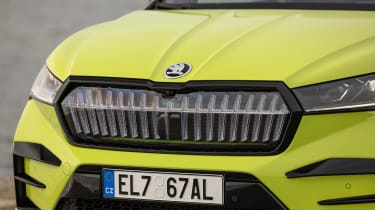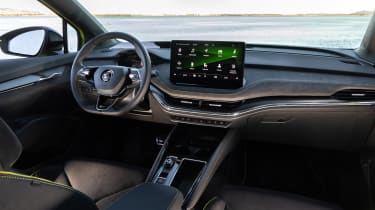Skoda Enyaq Coupe iV vRS 2022 review – ready to take on Hyundai's Ioniq 5
Skoda’s first electric vRS model arrives with nearly 300bhp and a sharp coupe body, but it lacks that vRS character we’ve come to admire
VW Group’s identikit approach to its electric vehicles continues apace with the latest editions to Skoda’s Enyaq family, with a coupe body style joining the regular SUV/estate model launched in 2021. It’s also Skoda’s first electric vRS model.
As with the VW ID4, Audi’s Q4 e-tron and the regular Enyaq the new coupe sits on the Group’s MEB platform, has a battery pack positioned between both axles and depending on the model either has a single motor on the rear axle or one fitted to both the front and rear, as per the RS tested here.
> That time we hit 227mph in a Skoda Octavia
With the RS you get an 82kW battery producing 220Kwh of energy, the equivalent of 295bhp and 339lb ft of torque. Which looks impressive until you remember it weighs the wrong side of 2200kg explaining a range in the region of 300 miles (in the seven thousand word press bump there wasn’t any mention of the VRS’s range or its exact weight. Can’t think why…). The resulting power-to-weight also explains the 136bhp/ton figure, which is on a par with a supermini from a generation ago, as are its performance figures – 0-62mph in 6.6 seconds, 111mph flat-out.
This combination of that hefty weight and low power output makes for a pretty flat driving experience. It doesn’t feel particularly sprightly even by yesterday’s standard’s when you ask both motors to deliver all they have, there certainly isn’t any EV acceleration heroics, rather it’s all a bit mild and underwhelming, which would be ok if Skoda’s internal combustion engined VRS products didn’t deliver above and beyond your expectations every time you drove them. But they do and they cast a shadow over the Enyaq Coupe vRS iV as a result.
More reviews
Dynamically it’s not an enlivening vRS experience either. Our test car was fitted with the optional Dynamic Chassis Control allowing you to fine tune the damper setting on a sliding scale. It gives the Enyaq a higher level of body control than expected and it deals with compressions and aggressive cambers remarkable well and even riding on 20-inch wheels it smothers poor surfaces. But when there’s load through the chassis when you encounter a compression all that mass has to go somewhere and a tension washes over the Enyaq as the energy can have you falling out of the unsupportive driver’s seat.
It comes up shorter when you reach a corner. The brakes are hard to modulate because they aren’t easy to judge. There’s an initial bite of retardation, then the slowing eases so you press some more and the pedal goes hard, so you ease off but it feels too much so you apply greater pressure again and trigger the ABS. It feels that there is another process of calibration required in order to deliver a consistent level of braking.
Slow it down and you’re into the next management phase of getting the nose turned in. Its mass means a big push wide from the front is the default, but you hear it from the tyres calling a truce before you feel anything happening. And because of its physical size and weight, making sudden corrections to deal with it is not the work of a moment. If you enjoy the fluidity and the no nonsense approach an Octavia vRS possesses you’ll need to lower your expectations when it comes to its electric brother.
In terms of dynamics and performance, like its VW cousin the ID4 GTX, the Enyaq coupe vRS feels undercooked. A badging exercise rather than a genuine vRS product. It lacks the character and individuality the Octavia and Kodiaq vRS deliver. There’s vRS detailing a plenty inside and out, that pair of sports seats that as well as failing to hold you in place are too short under your thigh, but there’s little else beneath the surface to make it standout as a performance derivative.
However, forget about the vRS name and look at it as an electric family car and there are few things to admire. There’s plenty of room - the rear seat occupants don’t lose any headroom over the standard Enyaq due to the standard fit glass roof - the interior is far nicer, and of a higher quality and better design than its ID4 and Q4 equivalents and its operating system stays true to Skoda’s simply clever mantra, such as the ability to have the off button for the Lane Keep Assist (a system even Skoda think is pointless, but it gets them a Euro NCAP rating) added to the touchscreen favourites bar.
The Enyaq, like so many others of its kind, will be a car bought through necessity rather than choice, especially if you’re a regular reader of this website or buy evo magazine, and if that’s the case the rear-drive single motor variant feels the better bet. And the more affordable one, too, because at £51,885 Is a steep ask.
Price and rivals
There are plenty of comparable rivals for the Skoda Enyaq vRS coupe, Ford’s £57,030 Mach-E being an obvious one. It’s expensive (aren’t they all?) and it’s interior is rather cheap looking and feeling, but dynamically it’s the more resolved of the two. Hyundai’s £45,145 Ioniq 5 and Kia’s £47,445 EV6 are both better electric cars in terms of functionality and usability and drive as well as the Skoda.
From within the VW Group is the forgettable £48,335 VW ID4 GTX and the underwhelming £51,370 Audi Q4 e-tron, of which the Skoda is the better option over both. Tesla’s £54,990 Model Y has also entered the game and delivers the Tesla USPs of continuous tech updates, superior powertrain tech otology, access to a charging network and the opportunity to be part of a cult. If it was our money we’d stretch the budget and go for Jaguar’s £65,195 I Pace, which offers the strongest blend of refinement, quality, dynamic prowess and desirability.







